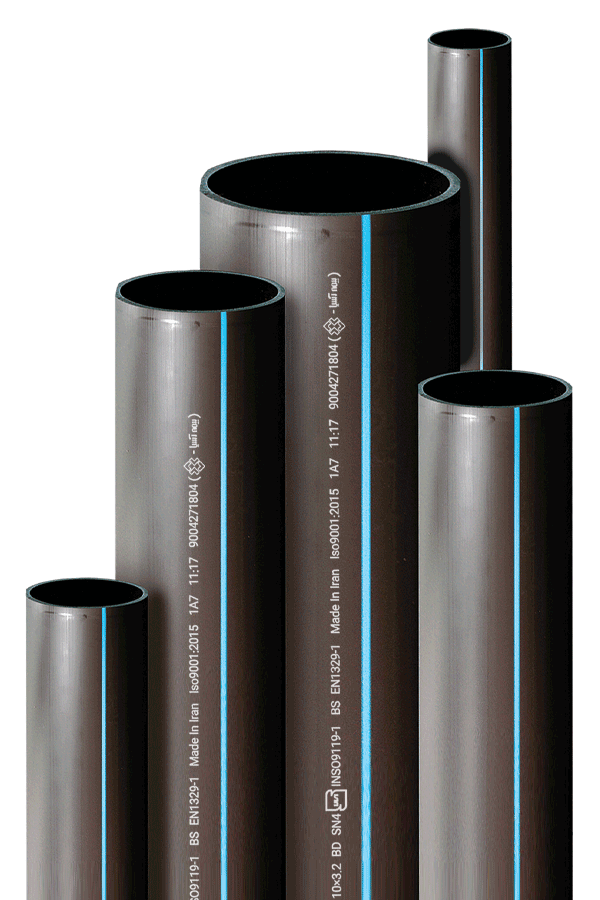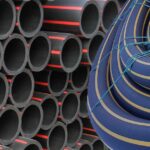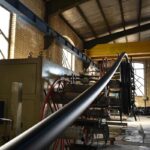The manufacturing process of polyethylene pipes through extrusion
- Article
- The manufacturing process of polyethylene pipes through extrusion

- July 4, 2023
- 8:17 am
- No Comments
The manufacturing process of polyethylene pipes through extrusion
It is necessary to know that polyethylene extrusion consists of the following stages:
- Preparing the raw material
- feeding the raw compound into the extruder
- Using wire mesh filter and a breaker plate
- Designing the pipe die
- Setting the pipe size
- Cooling the product
- Conveyor belt
- Product marking
- stacking tools
- Cutting and packaging tools
Preparing the initial raw material
Raw material used in the extrusion process include polyethylene resin, paint, and other components. Polyethylene resin is a thermoplastic polymer used in the manufacturing of toys, gas pipes, shopping bags, auto parts, etc.
Polyethylene resin should pass different physical tests during preparation phase. These tests include density, melting point, stress crack resistance, melt flow ratio, humidity, stability and resin contamination evaluation.
Finally, raw material is shipped to the factory in the form of pallets by truck or wagon. The pallets should be tested to see if they are UV and heat resistant. An important point in preparing raw material is to determine the color of the end product.
That is because pipe color determines its future applications. For example, coal black is used to produce water, sewer and industrial pipes. Yellow or a mixture of yellow and black colors are used to produce gas supply pipes while other colors are used in telecommunication lines.
An important point in determining the pipe color is that the manufacturer needs to follow the instructions. For example, dye extract cannot be changed by the manufacturer. Because this might affect pipe resistance in the long run. The final compound is sent to the second stage of extrusion through a vacuum pump.
feeding the initial compound into the extruder
 Extruder
Extruder
At the second stage of the polyethylene extrusion raw material is fed to the extruder. In this stage, raw material goes through changes like melting and mixing with other material. The end product is now ready for the third stage.
Extruders have components with different functions. These components include feeder screw, nut, mixing blade, welded ring, and spiral mixer. Screw is important for maintaining pipe quality and increasing pipe efficiency. Other components are used to mix resin with other material.
Mesh wire filter and breaker plate
In this stage of extrusion polymer will take a molten form. Mesh wire filter is used to prevent any polymer contamination since this makes homogenization easier. In addition to that, mesh wire filter distributes pressure along the screw equally.
The filter is protected by a hard steel screen called breaker plate. The screen pack consists of a mesh wire and several filters. Since the filter acts by removing contaminants from the polymer melt it needs to be replaced once in a while. This is done automatically in most extruders.
Die Design
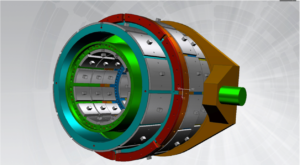 Extrusion die
Extrusion die
Die design is used to determine the shape and profile of the pipe. The die inlet is placed at the site of automatic screen changer. There are two types of die design:
- Spider die: the polymer melt is distributed around the mandrel through a hopper. Spider legs split the polyethylene melt into several pieces.
The circular surface of the flow channel homogenizes the flow. The end product enters another portion called land. The die land has a length of 15 to 20 times that of the circular section and a straight cross-section and gives the melt its final profile.
- Port-hole die: in this type of die the melt goes through a section called filter pack or a wire mesh cap with hundreds of holes. Next, the polymer melt forms a round and homogeneous shape under a certain amount of pressure. The advantage of this die compared to the spider die is in the converging flow of the polymer melt.
Sizing
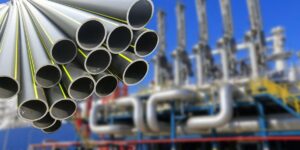 Polyethylene pipe
Polyethylene pipe
The sizing stage of polyethylene extrusion is done with chillers and pullers. In other words, sizing the pipe using chillers and pullers could be considered one stage. In this stage the hot product moving out of the die goes through pressure or vacuum system.
Later, the melt is placed in the sizing tube with chillers and pullers. The pipe maintains the desired round shape and dimensions due to its cooled surface. This stage should be completed carefully.
Cooling
Chillers should keep working at the sizing stage which happens under pressure or in a vacuum system. This helps maintain the round shape of the pipe and the pipe does not deform at the chiller outlet. Cooling is done by spraying and immersion.
Puller
As mentioned before, pulling is not a separate stage of polyethylene extrusion. pullers produce the required pulling force at the sizing stage.
In addition, pullers and the speed of the screw barrel help control the pipe schedule. It means the pipe schedule increases or decreases based on the speed of the puller.
Marking
Pipe marking is an important factor in polyethylene extrusion. The plastic type, flow rate, nominal size, product code, brand name, etc. of the pipe are mentioned at this stage. The marking should be done according to the international standards of ASTM.
Some of the methods used in marking pipes are heat sealing, offset printing, engraving, and inkjet printing. The pipe schedule needs to be checked during the marking process and make sure there is no leakage.
Stacking
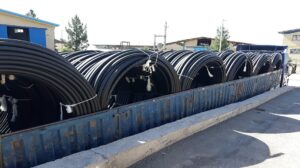 Coiled polyethylene pipes
Coiled polyethylene pipes
One of the options in supplying pipes is stacking them. Suppose pipes roll around a reel like a coil. These types of pipes are called coiled polyethylene pipes.
This makes shipping and working with pipes easier. These pipes can have a diameter of 6 inches and a maximum length of 10000 feet. Coiled pipes are the best option for water and gas supply lines when a higher length is preferred.
Cutting and packaging
The final stage in polyethylene extrusion is cutting and packaging. Pipes should get cut in sizes to facilitate shipping and storage.
Pipes are usually cut in 40 to 50 feet sizes. This length is suitable for pipes with a diameter of 4 inches. Polyethylene pipes with such diameters are easily loaded and unloaded during shipping by truck or wagon.

